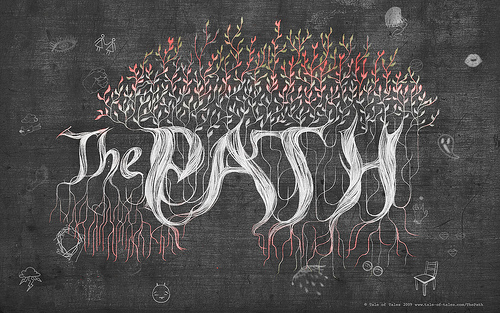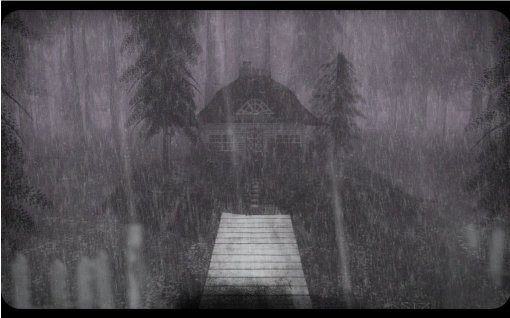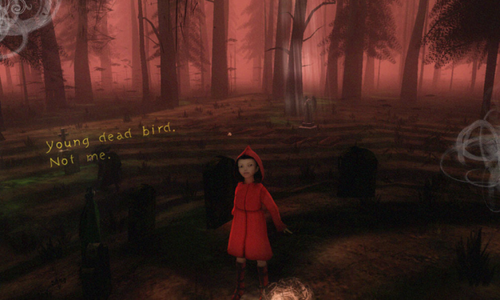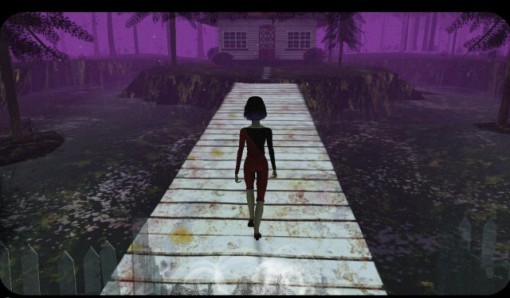The Path – “Do Not Stray from the Path”

There’s a growing consensus that traditional video-game forms aren’t permeable to an adult, artistic interpretation of interactivity. Games’ design matrix, with its its schemata of objectives, rewards and penalties, and its consistent orientation towards dexterity skills, tend to transform players into a pair of highly reflexive hands, directly wired to their senses. Art, on the other hand, has stronger requisites for its audience: a reflexive state of mind, a vast range of sensory processing, as well as the willingness to embark on an aesthetic and emotional voyage. A pair of waggling hands and fingers just doesn’t cut it. The Tale of Tales studio has a strong point of view on this matter – as they state in their own manifesto – “don’t make games”, but instead “real-time art”.

“The Path” is a “real time art” piece that challenges the boundaries of what a video-game can be, making a typical game-play description very ineffective in translating the experience. Interactivity in “The Path” is framed according to an architectural interpretation, meaning, players have a predominantly spatial relationship with the environment. Essentially, it’s a matter of choice – where to go next? Embodying your surroundings, by allowing your senses to perceive the form that encompasses you, just as you would in a famous architect’s latest work. “The Path” is just that – an aesthetically cohesive, narrative rich and artistically oriented form of three-dimensional exploration. Granted, most gamers will see this as an euphemistic way of saying that you can only *move* in the game. And, in a way, that’s true; you can’t shoot, jump or solve puzzles in “The Path”, and that’s exactly what makes it work. By using a minimalist form of interaction, Auriea Harvey and Michaël Samyn get players to willingly enter that reflexive stance that Art feeds upon. You experience “The Path”, you interpret it, you explore it, and above all, you feel it… but you never get to *play* “The Path”. In fact, it would be more correct to say that “The Path” plays you. And that’s why it makes for art in its purest form.

All of these formal nuances would be insignificant, if the aesthetic journey that lied beneath wasn’t worth it. But it is. “The Path” is a modern reinterpretation of “Red Riding Hood”, viewed through the lens of a horror aesthetic. It’s a dark and somber re-envisioning of the classic tale, brimming with sexual innuendo, heavy psychological violence and a wealth of adult themes, all captured through an extremely rich symbolic scenery, whose interpretation quickly becomes the main draw of the game. There’s no point in digressing over its exact nature, as each player’s interpretation is bound to be different, such is the depth of its metaphoric elements. Suffices to say, it’s an incredibly nuanced, complex narrative which the player must decode, but like in all good art pieces, that journey of discovery is an intricate part of the pleasure you’ll be able to extract from the game.

But despite having a rich narrative context, the game exposes it only through image, sound and a few poems, thus making it an even more provocative, personal and ambiguous experience. The aesthetic is stunning, to say the least – a mixture of Gothic, surreal landscapes, somewhat evocative of Japanese horror, but also showing traces of Lynch, Maya Daren or even Buñuel, all incarnated in the iconic figures that make up “Red Riding Hood”. The soundtrack follows the bizarre imagery’s vibe and features a strong emphasis on environmental sound effects; the ever-lurking growling of the wolf and the incessant children’s choir are particularly unsettling to hear. It’s obvious that its authors have an aesthetic sensibility that vastly surpasses the majority of games’ art designers, which in the end, is what allows them to implement their art-oriented game-design philosophy with unrivaled success.

Beautiful and enigmatic, strange and bewildering, horrifying but seductive; “The Path” is Art in its finest. It’s a bright sign saying that games can be adult and thought-provoking, just like any piece of fine Art. Because of it, developers now know that a new path for artistic video-game endeavors is, in fact, possible. Do not stray from “The Path”. Journey through it, embrace it, explore it. It may be the last path that can lead video-games into a bright future.
I believe the original tale had a different meaning from that which is used today – the childish bed-time story. Red Riding Hood was either a cautionary tale or something much deeper, in efect, possibly being used as a coded and masked comunication of something vital to children (especially little girls): the coming of age, the perils of distracting oneself while running an errand, greeting strangers, etc. So I think Tale of Tales went after the true meaning of the story instead of presenting (yet) another interpretation. More like a “reenactment” of the tale.
They use a style that befits the story, with a very clever underlining of the color red. It is unbelievable how a team of few has been able to gather all these resources. Also, I particularly enjoyed the way they made use of a visual layer that appears closer to the player, where they add seemingly random shapes that end up being of vital importance to the experience.
I totally agree with you Dieubussy-sama. Tale of Tales’ version went after the original meaning of the tale, and tried to recapture it, with a slightly different thematic background. I guess you’re right when you say that reinterpretation isn’t the best adjective for their version of “Red Riding Hood”. Of course, it comes to depend on what you interpret in both this version or the original. I am sure that many would disagree from our views regarding this tale 😉
As always, thanks for your enlightening comment. It’s a great pleasure to have you here.